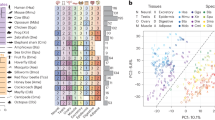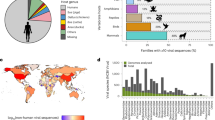Abstract
VERTEBRATES and invertebrates both have GABA (γ-aminobutyric acid) as a major inhibitory neurotransmitter1,2. GABAA receptors in vertebrates assemble as heteromultimers to form an integral chloride ion channel3. These receptors are targets for drugs and pesticides4 and are also implicated in seizure-related diseases5,6. Picrotoxinin (PTX) and cyclodiene insecticides are GABAA receptor antagonists which competitively displace each other from the same binding site7. Insects8 and vertebrates9 showing resistance to cyclodienes also show cross-resistance to PTX. Previously, we used a field-isolated Drosophila mutant Rdl (Resistant to dieldrin)10 insensitive to PTX and cyclodienes to clone a putative GABA receptor11. Here we report the functional expression and novel pharmacology of this GABA receptor and examine the functionality of a resistance-associated point mutation (alanine to serine) within the second membrane-spanning domain, the region thought to line the chloride ion channel pore. This substitution is found globally in Drosophila populations12. This mutation not only identifies a single amino acid conferring high levels of resist-ance to the important GABA receptor antagonist PTX but also, by conferring resistance to cyclodienes, may account for over 60% of reported cases of insecticide resistance13.
This is a preview of subscription content, access via your institution
Access options
Subscribe to this journal
Receive 51 print issues and online access
$199.00 per year
only $3.90 per issue
Buy this article
- Purchase on Springer Link
- Instant access to full article PDF
Prices may be subject to local taxes which are calculated during checkout
Similar content being viewed by others
References
Kuffler, S. W. & Edwards, C. J. Neurophysiol. 21, 589–601 (1965).
Usherwood, P. N. R. & Grundfest, H. J. Neurophysiol. 28, 497–518 (1965).
Olsen, R. W. & Tobin, A. J. FASEB J. 4, 1469–1480 (1990).
Eldefrawi, A. T. & Eldefrawi, M. E. FASEB J. 1, 262–271 (1987).
Meldrum, B. S. Br. J. clin. Pharmacol. 27, 3S–11S (1989).
Wagstaff, J. et al. Am. J. hum. Genet 49, 330–337 (1991).
Matsumura, F. & Ghiasuddin, S. M. J. environ. Sci. Hlth B18, 1–14 (1983).
Kadous, A. A., Ghiasuddin, S. M., Matsumura, F., Scott, J. G. & Tanaka, K. Pestic. Biochem. Physiol. 19, 157–166 (1983).
Yarbrough, J. D., Roush, R. T., Bonner, J. C. & Wise, D. A. Experientia 42, 851–853 (1986).
ffrench-Constant, R. H., Roush, R. T., Mortlock, D. & Dively, G. P. J. Ecol. Ent. 83, 1733–1737 (1990).
ffrench-Constant, R. H., Mortlock, D. P., Shaffer, C. D., Maclntyre, R. J. & Roush, R. T. Proc. natn. Acad. Sci. U.S.A. 88, 7209–7213 (1991).
ffrench-Constant R. H., Steichen, J., Rocheleau, T. A., Aronstin, K. & Roush, R. T. Proc. natn. Acad. Sci. U.S.A. (in the press).
Georghiou, G. P. in Pesticide Resistance: Strategies and Tactics for Management 14–43 (National Academy Press, Washington DC, 1986).
Imoto, K. et al. Nature 335, 645–648 (1988).
Leonard, R. J., Labarca, C. G., Charnet, P., Davidson, N. & Lester, H. A. Science 242, 1578–1581 (1988).
Blair, L. A., Levitan, E. S., Marshall, J., Dionne, V. E. & Barnard, E. A. Science 242, 577–579 (1988).
Lummis, S. C. Comp. Biochem. Physiol. 95, 1–8 (1990).
Feigenspan, A., Wassle, H. & Bormann, J. Nature 361, 159–161 (1993).
Qian, H. & Dowling, J. E. Nature 361, 162–164 (1993).
Shimada, S., Cutting, G. & Uhl, G. R. Molec. Pharmac. 41, 683–687 (1992).
ffrench-Constant, R. H. & Rocheleau, T. J. Neurochem. 59, 1562–1565 (1992).
Harvey, R. J. et al. EMBO J. 10, 3239–3245 (1991).
Bloomquist, J. R., ffrench-Constant, R. H. & Roush, R. T. Pestic. Sci. 32, 463–469 (1991).
ffrench-Constant, R. H. & Roush, R. T. Genet. Res. Camb. 57, 17–21 (1991).
Pribilla, I., Takagi, T., Langosch, D., Bormann, J. & Betz, H. EMBO J. 11, 4305–4311 (1992).
Roush, R. T. & McKenzie, J. A. A. Rev. Ent. 32, 361–380 (1987).
Noda, M. et al. Nature 299, 793–797 (1982).
Satelle, D. B. et al. in Transmitter Amino Acid Receptors, Structures, Transduction and Models for Drug Development (eds Barnard, E. A. & Costa, E.) 273–291 (Thieme Medical, New York, 1992).
Schofield, P. R. et al. Nature 328, 221–227 (1987).
Pritchett, D. B. et al. Nature 338, 582–585 (1989).
Shivers, B. D. et al. Neuron 3, 327–337 (1989).
Cutting, G. R. et al. Proc. natn. Acad. Sci. U.S.A. 88, 2673–2677 (1991).
Author information
Authors and Affiliations
Rights and permissions
About this article
Cite this article
ffrench-Constant, R., Rocheleau, T., Steichen, J. et al. A point mutation in a Drosophila GABA receptor confers insecticide resistance. Nature 363, 449–451 (1993). https://doi.org/10.1038/363449a0
Received:
Accepted:
Issue Date:
DOI: https://doi.org/10.1038/363449a0
This article is cited by
-
Detection of insecticide resistance markers in Anopheles funestus from the Democratic Republic of the Congo using a targeted amplicon sequencing panel
Scientific Reports (2023)
-
The power of Drosophila genetics in studying insect toxicology and chemical ecology
Crop Health (2023)
-
Fitness costs associated with a GABA receptor mutation conferring dieldrin resistance in Aedes albopictus
Heredity (2022)
-
Pharmacological modulation of fish-induced depth selection in D. magna: the role of cholinergic and GABAergic signalling
Scientific Reports (2021)
-
RDL mutations in Guangxi Anopheles sinensis populations along the China–Vietnam border: distribution frequency and evolutionary origin of A296S resistance allele
Malaria Journal (2020)
Comments
By submitting a comment you agree to abide by our Terms and Community Guidelines. If you find something abusive or that does not comply with our terms or guidelines please flag it as inappropriate.



